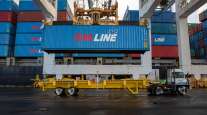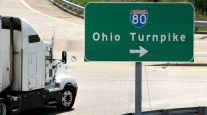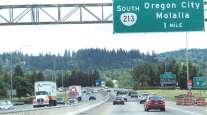Staff Reporter
Comments to Oregon DOT Reveal Concerns Over I-205 Tolls
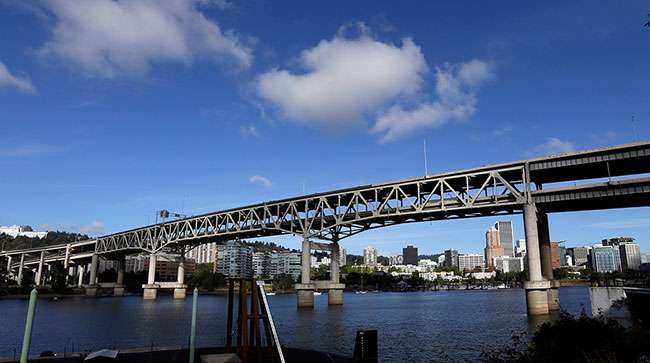
[Stay on top of transportation news: Get TTNews in your inbox.]
As part of its study on the potential of tolls in the Portland area, the Oregon Department of Transportation will consider 4,644 public comments, the majority of which express opposition to the tolls.
ODOT had called for comments on the potential use of tolls on a stretch of Interstate 205, which wraps around the east side of the Portland metropolitan area and extends into Washington state. The segment in question is near the Abernethy Bridge, which carries the interstate over the Willamette River. The bridge is about 12 miles south of downtown Portland.
In the comments, frequently mentioned issues pertained to tolling’s impact on low-income communities, the need for transit and other transportation choices, and the prospect of traffic diverting to local streets to avoid tolls. According to ODOT’s Engagement Summary, respondents expressed “strong opposition” to tolling and concern that tolls would be a financial hardship for their households, particularly during the COVID-19 pandemic.
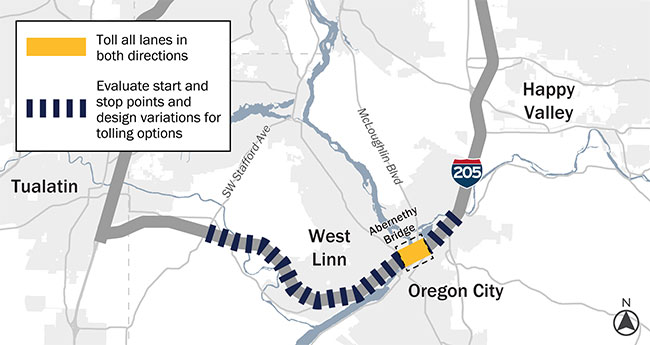
The map shows the general area where tolls could help raise revenue and manage congestion, ODOT says. (Oregon Department of Transportation)
Other economic concerns included impacts to the freight industry that relies on I-205 and effects on local businesses situated near the tolled area. Besides residents and businesses that are located near I-205, ODOT sought comment from local, regional and regulatory agencies and members of underserved communities.
Many respondents wondered how much the tolls would cost and what the tolls would pay for. A few respondents said certain user groups, such as “freight-trucking industries” or out-of-state commuters, should have to pay more.
“Distrust of government in general, as well as ODOT in particular, was expressed,” the Engagement Summary states. “There were many messages in opposition to tolls that directed ODOT to ‘live within your means’ of available funding and accused ODOT of a ‘money grab.’ ”
In terms of addressing potential negative effects of tolls, respondents suggested toll discounts, maintenance of toll-free routes and increased transit options. Specifically, suggestions included discounts or toll exemptions for locals or low-income drivers, rates that vary by time of day, a monthly or annual cap on toll rates and fixing local roads before tolls are established so they can better function as alternate routes.
Managing congestion is a key goal for the tolling program. The revenue generated from the tolls is meant to help fund highway improvements along the corridor. However, respondents disagreed as to how revenue should be spent. Some were in favor of roadway expansions, while others thought revenue should be used to expand other transportation facilities, such as transit and bike paths.
“We recognize that transportation funding is limited and we have large needs in Oregon,” Jana Jarvis, president of Oregon Trucking Associations, told Transport Topics. “We are willing to consider the tolling option if we get the corresponding improvements and the reduction of congestion that would improve our efficiency.”
I-205Toll EngagementSummary... by Transport Topics
While OTA did not formally submit input as one of the 4,644 comments, Jarvis said she has been part of the tolling discussion through her work on the state’s legislatively approved task force on pricing strategies.
Over the next couple of months, ODOT and the Federal Highway Administration will consider the comments. ODOT plans to respond to them in a separate document, scheduled for publication early next year. The agency aims to set toll rates in 2023, and tolling is expected to begin after 2024.
“Clearly there is more work to do,” ODOT Toll Program Director Lucinda Broussard said. “With so many unknowns, it’s easy to understand why no one wants to pay more for travel. However, tolling projects in regions like ours show us once a toll is implemented, trips improve and travel times reduce.”
Relieving congestion and improving quality of life were priorities outlined in the Keep Oregon Moving Act of 2017, which was designed to rely on taxes and fees to produce revenue for transportation investment.
Want more news? Listen to today's daily briefing:
Subscribe: Apple Podcasts | Spotify | Amazon Alexa | Google Assistant | More


